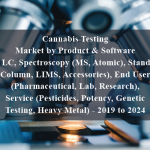OVERVIEW
The Cell Culture Market is currently valued at USD 30.9 billion in 2024 and will be growing at a CAGR of 13.4% over the forecast period to reach an estimated USD 57.9 billion in revenue in 2029. The cell culture market encompasses a broad range of products, services, and technologies aimed at the growth and maintenance of cells under controlled conditions outside of their natural environment. This market is pivotal for numerous applications across biomedical research, biotechnology, pharmaceutical development, and the production of therapeutic proteins and vaccines. The demand within this market is driven by the growing need for personalized medicine, the expansion of regenerative medicine, and the continuous advancements in cell-based research. Key components of the market include cell culture media, sera, reagents, cell lines, tissue culture plates, and bioreactors, which facilitate the study of cellular mechanisms in vitro, drug testing, and the production of biological products. Innovations in 3D cell culture and stem cell research further fuel market growth, offering more physiologically relevant models and accelerating the pace of medical discoveries and therapeutic development. As such, the cell culture market is a crucial and expanding field that plays an essential role in modern science and healthcare.
The cell culture market is propelled by several key drivers, including the rapid advancements in biotechnology and life sciences research, the increasing demand for biopharmaceuticals and vaccines, and the rising focus on personalized medicine. Technological innovations, such as the development of 3D cell culture techniques and automated cell culture systems, offer more realistic models for drug discovery and disease modeling, significantly enhancing research quality and efficiency. The expansion of regenerative medicine and stem cell research presents further growth opportunities, as these areas rely heavily on cell culture technologies for developing therapies for various diseases. Moreover, the global rise in chronic diseases and the need for more effective treatments fuel the demand for research and development activities in the pharmaceutical and biotechnology sectors, driving the adoption of cell culture products. Government support and funding for biomedical research in many countries also contribute to the market’s growth, ensuring ongoing advancements and the application of cell culture technologies across multiple scientific and therapeutic areas.
Table of Content
Market Dynamics
Drivers:
The cell culture market is propelled by several key drivers, including the rapid advancements in biotechnology and life sciences research, the increasing demand for biopharmaceuticals and vaccines, and the rising focus on personalized medicine. Technological innovations, such as the development of 3D cell culture techniques and automated cell culture systems, offer more realistic models for drug discovery and disease modeling, significantly enhancing research quality and efficiency. The expansion of regenerative medicine and stem cell research presents further growth opportunities, as these areas rely heavily on cell culture technologies for developing therapies for various diseases. Moreover, the global rise in chronic diseases and the need for more effective treatments fuel the demand for research and development activities in the pharmaceutical and biotechnology sectors, driving the adoption of cell culture products. Government support and funding for biomedical research in many countries also contribute to the market’s growth, ensuring ongoing advancements and the application of cell culture technologies across multiple scientific and therapeutic areas.
Key Offering:
The key offerings in the cell culture market encompass a diverse range of products and technologies designed to support the growth, maintenance, and analysis of cells in vitro. Central to these offerings are cell culture media, which provide the essential nutrients for cell growth, and sera, such as fetal bovine serum, which supplement the media with growth factors and hormones. Reagents, including antibiotics and buffers, ensure the optimal pH and sterility of cultures. The market also includes a variety of cell lines, from primary cells to immortalized and genetically engineered cells, tailored for specific research needs. Tissue culture plates, flasks, and bioreactors are critical for housing and scaling up cultures, with advanced systems offering automation and precise environmental control to mimic in vivo conditions. Additionally, 3D culture systems and scaffolds support the growth of cells in three dimensions, providing more physiologically relevant models for tissue engineering and drug testing. Innovations in cell culture instruments, such as cell counters and imaging systems, facilitate the monitoring and analysis of cell growth and behavior. Together, these offerings play a vital role in advancing biomedical research, drug discovery, and the production of biologics, showcasing the cell culture market’s crucial role in modern science and healthcare.
Restraints :
The cell culture market, while robust and growing, faces several restraints that can hinder its expansion. One of the primary challenges is the high cost associated with advanced cell culture technologies and reagents, particularly those involving 3D cell culture systems and automated processes, which may limit their accessibility to smaller research institutions and startups. Ethical and regulatory issues surrounding the use of certain cell lines, especially human embryonic stem cells, also pose significant hurdles, leading to strict oversight and potentially delaying research and product development. Furthermore, the complexity and sensitivity of maintaining cell cultures require specialized knowledge and facilities, making it challenging to ensure consistency and reproducibility across different labs. The risk of contamination and the need for stringent sterility controls add another layer of complexity and cost. Additionally, the reliance on animal-derived components, like fetal bovine serum, raises concerns about supply chain sustainability and batch-to-batch variability, prompting a search for synthetic alternatives. These restraints underscore the balance between innovation and accessibility, ethical considerations, and operational challenges in the cell culture market.
Regional Information:
North America, particularly the United States, dominates the market due to its strong biotechnology and pharmaceutical sectors, substantial investments in research and development, and the presence of leading companies and research institutions. Europe follows, with countries like Germany, the UK, and France leading in biomedical research, supported by government funding and collaborative research projects. The Asia-Pacific region is witnessing rapid growth, driven by increasing investments in healthcare and biotechnology, growing demand for personalized medicine, and improvements in research infrastructure. Countries like China and India are emerging as key players, benefiting from government support and a growing focus on biopharmaceuticals. Meanwhile, regions such as Latin America and the Middle East and Africa are experiencing gradual growth, with the expansion of research facilities and healthcare reform initiatives. These regional dynamics reflect the global reach of the cell culture market, influenced by local economic conditions, regulatory policies, and the strategic priorities of nations in advancing healthcare and scientific research.
Recent Developments:
• In September 2023, Thermo Fisher Scientific launched the Gibco CTS Detachable Dynabeads, a groundbreaking platform with an innovative active-release mechanism designed for the clinical and commercial operation of cell therapy manufacturing.
• In December 2023, Danaher acquired Abcam, a provider of validated antibodies, reagents, biomarkers, and assays crucial for drug discovery, life sciences research, and diagnostics. Within Danaher’s Life Sciences segment, Abcam will continue to operate independently, aligning with Danaher’s mission to advance disease understanding and expedite drug discovery.
Key Players:
Thermo Fisher Scientific Inc., Merck KGaA, GE Healthcare (Cytiva), Corning Incorporated, Becton, Dickinson and Company (BD), Lonza Group AG, Sartorius AG, Eppendorf AG, Sigma-Aldrich Corporation (now part of Merck KGaA), Danaher Corporation
Frequently Asked Questions
1) What is the projected market value of the Cell Culture Market ?
– The Cell Culture Market is expected to reach an estimated value of USD 57.9 billion in revenue by 2029.
2) What is the estimated CAGR of the Cell Culture Market over the 2024 to 2029 forecast period?
– The CAGR is estimated to be 13.4% for the Cell Culture Market over the 2024 to 2029.
3) Who are the key players in the Cell Culture Market ?
– Thermo Fisher Scientific Inc., Merck KGaA, GE Healthcare (Cytiva), Corning Incorporated, Becton, Dickinson and Company (BD), Lonza Group AG, Sartorius AG, Eppendorf AG, Sigma-Aldrich Corporation (now part of Merck KGaA), Danaher Corporation.
4) What are the drivers for the Cell Culture Market ?
– The cell culture market is driven by biotechnology advancements, biopharmaceutical demand, and personalized medicine. Technological innovations like 3D cell culture techniques enhance research quality. The expansion of regenerative medicine and stem cell research presents growth opportunities. The global rise in chronic diseases and government support for biomedical research further drive the market’s growth.
5) What are the restraints and challenges in the Cell Culture Market ?
– The cell culture market faces challenges such as high costs, ethical concerns, and operational challenges. Advanced technologies and reagents are expensive, making them difficult for smaller institutions. Ethical issues, such as human embryonic stem cell use, require strict oversight. Maintaining cell cultures requires specialized knowledge and facilities, and reliance on animal-derived components raises sustainability and variability concerns.
6) What are the key applications and offerings of the Cell Culture Market ?
– The cell culture market offers various products and technologies for in vitro cell growth, maintenance, and analysis. Key offerings include cell culture media, serum, reagents, cell lines, tissue culture plates, flasks, bioreactors, 3D culture systems, and cell culture instruments. These offerings are crucial for biomedical research, drug discovery, and biologics production, showcasing the market’s vital role in modern science and healthcare.
7) Which region is expected to drive the market for the forecast period?
– North America is expected to have the highest market growth from 2024 to 2029
Why Choose Us?
Insights into Market Trends: Global Market Studies reports provide valuable insights into market trends, including market size, segmentation, growth drivers, and market dynamics. This information helps clients make strategic decisions, such as product development, market positioning, and marketing strategies.
Competitor Analysis: Our reports provide detailed information about competitors, including their market share, product offerings, pricing, and competitive strategies. This data can be used to inform competitive strategies and to identify opportunities for growth and expansion.
Industry Forecasts: Our reports provide industry forecasts, which will inform your business strategies, such as investment decisions, production planning, and workforce planning. These forecasts can help you to prepare for future trends and to take advantage of growth opportunities.
Access to Industry Experts: Our solutions include contributions from industry experts, including analysts, consultants, and subject matter experts. This access to expert insights can be valuable for you to understand the market.
Time and Cost Savings: Our team at Global Market Studies can save you time and reduce the cost of conducting market research by providing comprehensive and up-to-date information in a single report, avoiding the need for additional market research efforts.












